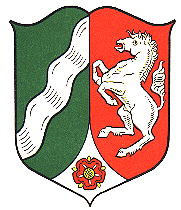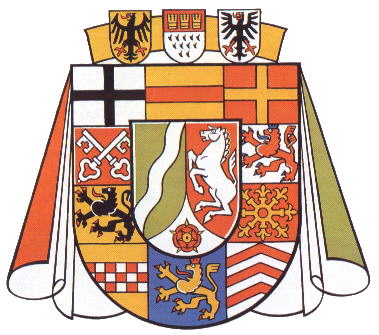Nordrhein-Westfalen: Difference between revisions
Knorrepoes (talk | contribs) m (Text replacement - "ö" to "ö") |
Knorrepoes (talk | contribs) m (Text replacement - ".jpg|center]]" to ".jpg|center|Wappen von {{PAGENAME}}]]") |
||
| Line 2: | Line 2: | ||
'''NORDRHEIN-WESTFALEN''' | '''NORDRHEIN-WESTFALEN''' | ||
[[File:nordrhei.jpg|center]]<br/> | [[File:nordrhei.jpg|center|Wappen von {{PAGENAME}}]]<br/> | ||
====Origin/meaning==== | ====Origin/meaning==== | ||
| Line 22: | Line 22: | ||
{|align="center" | {|align="center" | ||
|align="center"|[[File:nrw2.jpg|center]] <br/>The design of 1958 | |align="center"|[[File:nrw2.jpg|center|Wappen von {{PAGENAME}}]] <br/>The design of 1958 | ||
|} | |} | ||
Revision as of 17:12, 29 October 2016
This page is part of the German heraldry portal Deutsche Wappensammlung |
Heraldry of the World |
|
German heraldry:
|
Selected collector's items from Germany:
|
NORDRHEIN-WESTFALEN
Origin/meaning
The arms were granted on March 10, 1953.
The arms are a combination of the rose of Lippe, the stallion of Westfalen and the arms of the Grand-Duchy Niederrhein.
The rose of Lippe is taken as a large part of the state was part of the Principality of Lippe, which became a province of Prussia in 1921. The rose as arms for the counts of Lippe is known since Bernard II zur Lippe (1167-1200).
Westfalen was first a duchy. later a grand-duchy under the arch-bishops of Köln (Cologne). Ever since arms of Westfalen are known, the stallion was part of the arms. The stallion itself is derived from the arms of the Nieder Sachsen (lower Saxony area, not the present State). It was also one of the major symbols in the arms of the (short-lived) Kingdom of Westfalen in the 19th century and the Prussian Province of Westfalen.
The white bend symbolises the river Rhein (Rhine) flowing through fertile land. It was devised in 1817 for the Prussian Rheinprovince and grand-duchy Niederrhein.
In 1958/59 there was some interest in devising Great-arms of Nordrhein-Westfalen, which were supposed to be made up of the arms of the ten most important historical parts of the state, and the present arms were to be added as an escutcheon.
The historical areas were : State of Köln (cross), Paderborn, Münster, Minden, Berg (a red lion, with blue tongue, crown and nails) Jülich, Kleve, Mark (see the arms of Hamm), Ravensberg and Geldern. Above the shield the arms of the cities of Aachen, Köln and Duisburg.
As these arms would be rather complicated the plan was dropped.
| The design of 1958 |
Contact and Support
Partners:
Your logo here ?
Contact us
© since 1995, Heraldry of the World, Ralf Hartemink 
Index of the site
Literature : Stadler, K. : Deutsche Wappen - Bundesrepublik Deutschland. Angelsachsen Verlag, 1964-1971, 8 volumes.













